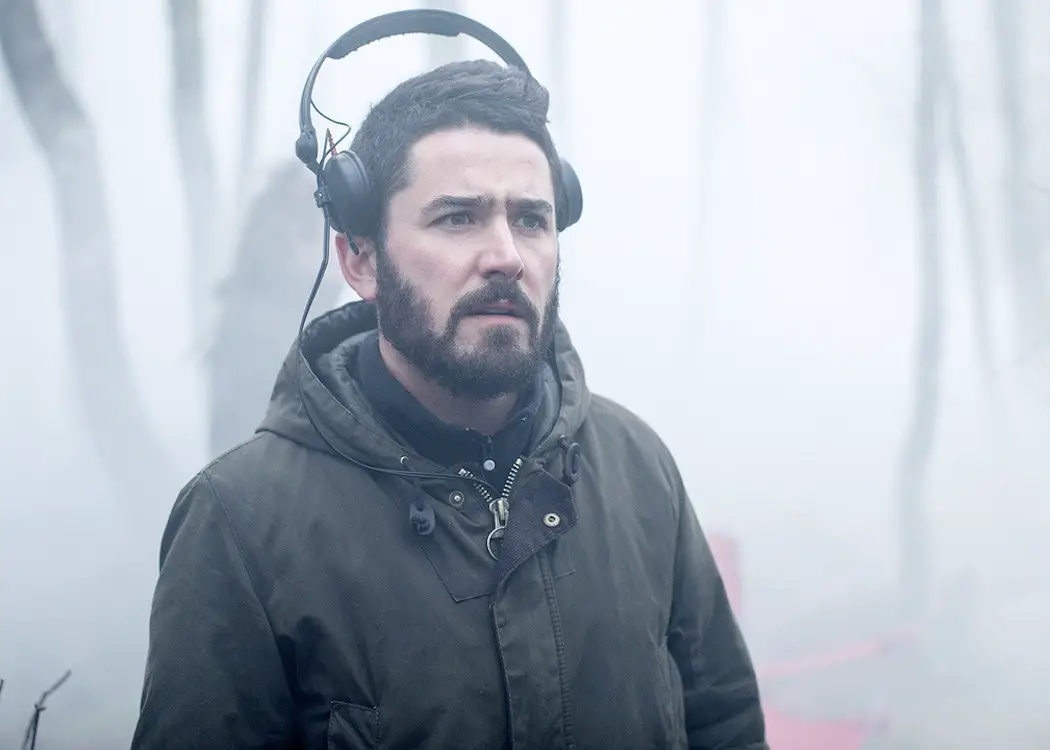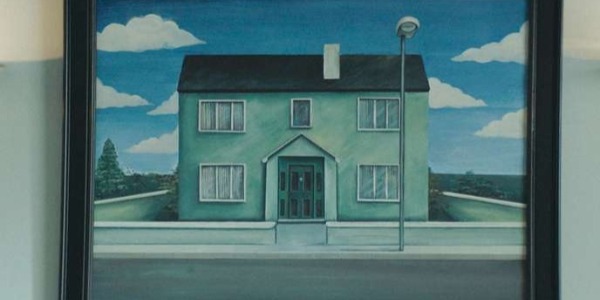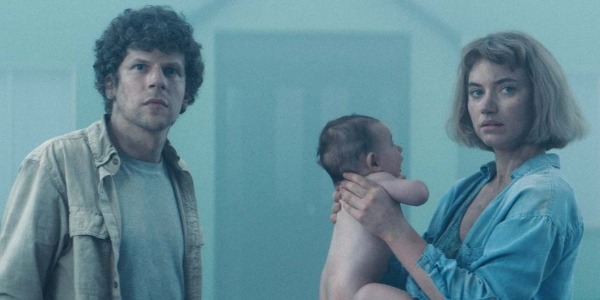Melbourne International Film Festival 2019: Interview With Lorcan Finnegan, Director Of VIVARIUM

Alex is a 28 year-old West Australian who has a…
The definition of the word “vivarium” is an enclosed area, usually for keeping and raising animals or plants for observation or research. There’s a number of ways this description can be applied to the film of the same name, the latest science-fiction festival hit from Irish director Lorcan Finnegan.
Arriving at the same time as Riley Stearns’ The Art of Self Defence, Vivarium sees Imogen Poots and Jesse Eisenberg re-teaming as a couple who are on the market for their first home. When they agree to tour the monotonous properties of Yonder, a housing property lined up hundreds of sickly green, identical residences that’d make Tim Burton blush, they find themselves abandoned and unable to escape – then in true Twilight Zone fashion, a box arrives with a baby inside.
It sounds strange enough, but this is only the tip of the iceberg, and Finnegan and writer Garret Shanley have fun slowly dispensing Yonder’s many elusive secrets to the tortured couple. Vivarium is a wholly original piece, and to unveil any more of its warped plot details would be a disservice to the film’s bounty of surprises and reveals.
With Vivarium playing at the Melbourne International Film Festival this year, I was able to talk with Lorcan Finnegan about his latest film, its relation to his previous work, how he met Garret Shanley and the film’s artistic influences.
Alex Lines for Film Inquiry: How was it premiering Vivarium at Cannes earlier this year?
Lorcan Finnegan: Yeah it was amazing, it was crazy, we got offered the Directors Fortnight and Critics Week, and we thought Critics Week would be the better option and we kind of popped because we were a genre film so we had to finish the film on time, to get it in. We only finished the film two days before the festival, we had to get it there to do the subtitles and everything so, it was kind of perfect timing.
It’s much nicer than finishing a film and then waiting for a festival that’s three months away or something. It was great, its a great festival. I had never been to Cannes before so it was obviously awesome to go there with a film in the festival.
This film is based in part on a previous short of yours, Foxes, can you talk about the development of that short to the feature-length Vivarium?
Lorcan Finnegan: Foxes is a reaction with what was going on politically in Ireland at the time. It’s all to do with the economy, the government was giving all these EU grants and banks were giving out 100% mortgages and the result was shady development going on where people were building these massive housing developments in the middle of nowhere in Ireland and charging a fortune for them and then banks giving people 100% mortgages to buy them.
So, there were people buying places where like, a couple who ended up buying a house in the space of like 200 houses and they could be the only people living there. And then, it was sort of time passing as well, then the crash came and a lot of these places just were left unfinished. They’ve since been demolished actually, such a waste. So in Foxes, a couple were kind of financially and emotionally trapped in this kind of ghost estate where nature was encroaching, kind of taking it back again and the woman has to rejoin nature in a supernatural way to kind of escape.
But there are themes of the atomisation of society, capitalism, consumerism, greed, all those kind of things that we were interested in, that we kind of touch on in Foxes that we kind of wanted to expand upon in a feature format. So Garret and I started writing, we were working on Vivarium back in like 2012 probably. It was kind of a mixture of that plus an interesting nature documentary on the lifecycle of the European cuckoo with David Attenborough that amalgamated into Vivarium.

The film’s production design and general aesthetic are quite striking – what were your artistic influences in terms of the film’s look?
Lorcan Finnegan: I was trying to figure this out because it’s difficult to tell after a while but I was definitely influenced by Roy Andersson’s films because he builds sets and exterior sets inside a warehouse. Olafur Eliasson, the light artist, had a project when I was living in London, he had a weather project on at the Tate with his giant fake sun, which inspired me.
The photography of Andreas Gursky with the repetition as well. There’s a film by Hiroshi Teshigahara called the Woman in the Dunes – It’s not really an aesthetic influence, it’s more of a schematic influence. Actually a very obvious reference would be the The Empire of Light by Magritte. That was actually in the script, so we kind of designed parts of it to look like Magritte’s painting, especially the surrealism in there.
Now was this shot before or after Art of Self Defence?
Lorcan Finnegan: It was after, yeah, it’s crazy because I know Riley [Riley Stearns, the director of The Art of Self Defence], we’ve kind of been friends – sort of online buddies on social media, Vimeo etc. because he made a short film called The Cub at the same time as I made Foxes, but they ended up being programmed in the same strand at a lot of festivals. And then, we started casting our features at the same time and going into prep. He shot before me and actually when he wrapped, he went on a European holiday and his first stop was Dublin so we met up and we were talking. This is before I had actually cast – I think I had just cast Imogen Poots.
It was weird because I cast Imogen originally, it wasn’t until a little bit later that we went out to Jesse Eisenberg and it was Imogen who suggested Jesse and I thought, “Yeah, why that would be really interesting.” And of course of she’d worked with him not so long before so, it’s weird. It’s kind of cool to have them together again. I’ve seen the The Art of Self Defence, its great, but it’s Jesse’s movie where as Vivarium is Imogen’s movie.
With a film like this, that has such a Twilight Zone style, was there ever the temptation to explain yourself? I do feel like Jordan Peele’s film Us hurt itself from trying to make its science-fiction elements too literal/real.
Lorcan Finnegan: A lot of time, I just find that it’s always the case that if you show people, especially when something is very mysterious, people have their own versions in their head, they’re actually consciously creating these kind of worlds, these explanations, that a lot of times, it can be a bit like, “Oh, I’ve thought of something much better.” once you reveal your own explanation.
Actually we did have an earlier draft where we did explain more. We actually even shot a bit more towards the last 15 minutes, where we did actually give a little more information but we took it out in the edit. Because the film was informing itself as well and informing what it was as we were cutting it. With the performances and the tone, I was really enjoying it as more of a serious film. There’s also a lot films that I really like that leave it ambiguous. It’s not completely unexplained, but there’s just some stuff going on that isn’t fully explained. I think even if it was explained, it’s not like it would make any sense. There’s so much metaphor in it that I think you’ll get what it’s about without making it all literal.
Between your previous shorts and Without Name and now this, can you talk about your creative relationship with Garret Shanley?
Lorcan Finnegan: We met at a low budget film making conference type thing back in 2007. It’s a thing called Catalyst Project where the Irish Film Board – they’re called Screen Ireland now – but at the time they were called the Irish Film Board, were going to give out three grants of $300,000 to make a movie. We applied and we had to do all these seminars on low budget feature making and they brought over some Danish filmmakers. Ireland at the time was trying to emulate what they’ve done in Denmark, the Danish actually watch their own films and we don’t.
We met at that and came up with a story called Utopia about a guy who invented this kind of Second Life type world and he created a character who is everything that he isn’t, but the character ends up coming into the real world and sucking people up into USB drives and locking them up in a virtual world. It was super expensive and there was no way we were doing that with a low budget so we didn’t get it but we had a good laugh about it.
Garret has this blog called Fug The World and I was reading it at the time we met and there’s some hilarious, weird stories on there and one of them, which wasn’t much a comedy but it was very visually interesting, schematically interesting, was a short story called Foxes, which we ended up developing into the script. It’s changed quite a bit but its the one we turned into the short film. After we applied for funding for that and we got it, we did some other shorts and then we went back for the next round of Catalyst which was some years later and we got the financing to make Without Name.

How do you feel that your history in graphic design has impacted your directorial style?
Lorcan Finnegan: Yeah, I mean it’s hard to tell from an outside perspective, but yeah, I mean I studied graphic design originally, but I actually thought graphic design was motion graphics, animation, that kind of stuff. I started and it was all images and text, but it was still great. It was a good formal training in composition, colour, symmetry, all of that kind of stuff, and then whenever I started a graphic project, they were always leaning towards narrative structure.
And then I started doing animated things. I liked creating worlds but I didn’t have any equipment or money to develop anything, My first two shorts I did were a mixture of live-action and animation. I like to create a world, an environment to drop these characters in, and these environments end up becoming a big part of it, and I think that comes from my graphic design history.
Does the film have an official release date/distributor yet?
Lorcan Finnegan: Yeah, it’s sold all over the place – In Australia and New Zealand it’s being distributed by Umbrella Entertainment. I think its going to be theatrically released all over the world – smallish, but still theatrical. It’s being held back by the US distributors, because they want to release in the first quarter of next year, looking around March or April I’d say.
Film Inquiry thanks Lorcan Finnegan for taking the time to talk with us.
Vivarium is currently doing the international festival circuit, with a US theatrical release dated for early next year. Updates in regarding the film’s release can be found at Lorcan Finnegan’s Twitter account: https://twitter.com/lorcanfinnegan
Are you excited about this film? Let us know in the comments.
Does content like this matter to you?
Become a Member and support film journalism. Unlock access to all of Film Inquiry`s great articles. Join a community of like-minded readers who are passionate about cinema - get access to our private members Network, give back to independent filmmakers, and more.













